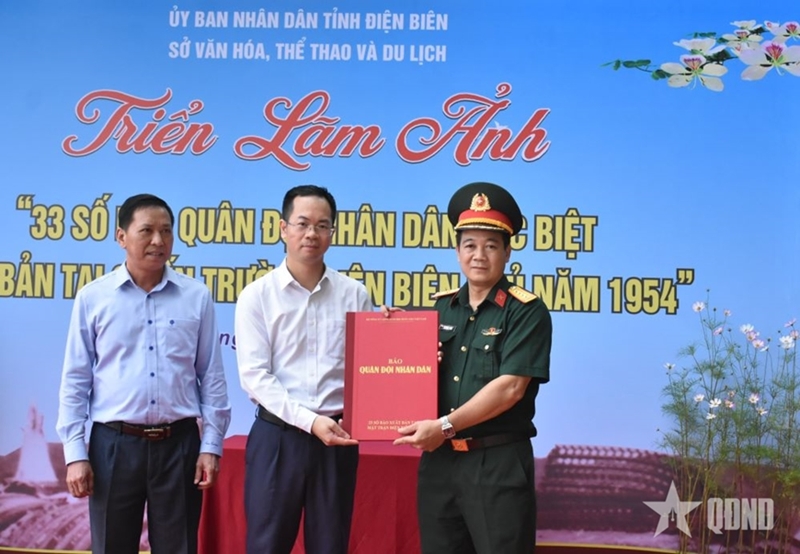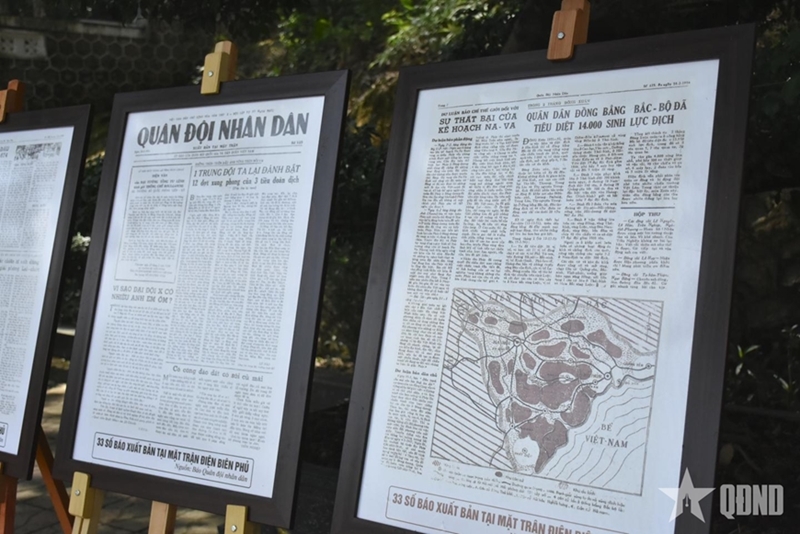These issues vividly captured the combat activities, daily lives of soldiers and civilians, and the latest developments of the historic campaign. They also honored the courage and resilience of those who fought fearlessly against the enemy, reflecting an unshakable belief in the ultimate victory.
    |
 |
|
The PAN’s representative presents 33 issues published at the Dien Bien Phu battlefield to the Department of Culture, Sports and Tourism of Dien Bien Province. |
The field editorial office and printing facility were located on the slope of Pu Ma Hong Hill (also known as Ngua Hi Hill) in Muong Phang, just across a field from the dugouts of the Commander-in-Chief and the Polical Chief of the front. From this vantage point, the PAN’s reporters received official information from the campaign’s command post and promptly delivered it to troops and conscripted labors.
The first issue was published on December 28, 1953, numbered 116 in continuation with the rear edition. The front page carried the headline: “Democratic Republic of Vietnam, Year X – Independence, Freedom, Happiness,” followed by “People’s Army Newspaper Published at the Front - Newspaper of the Military and Vietnamese Militia.” Initially, the paper was printed on two pages and released every four to five days. By March 1954, the publication frequency increased to one issue every two to three days, and at times even daily.
During the Lunar New Year of the Horse in 1954, soldiers and conscripted labors were deeply moved to read President Ho Chi Minh’s handwritten New Year’s greetings printed in the February 1, 1954 issue. On May 11, 1954, issue No.147 carried the bold headline across its front page: “Commander-in-Chief Vo Nguyen Giap announced that our military has achieved complete victory at the Dien Bien Phu battlefield.” Five days later, on May 16, 1954, the front office published its No.148 and final issue at the front, a special edition celebrating the Dien Bien Phu Victory.
Throughout those months, the newspaper reflected political and social events both domestically and internationally with accuracy and timeliness. Above all, it provided objective coverage of the Dien Bien Phu Campaign, celebrating acts of bravery and heroism while remaining honest about shortcomings. For example, issue No.117 praised the soldiers who “used their backs as mounts for machine guns” in battle against the French troops. In contrast, issue No.143, dated April 10, 1954, reported on a case in which a field evacuation station staff member was prosecuted before the military court for violating battlefield discipline.
The then office consisted of only five members, namely Hoang Xuan Tu (chief editor), Tran Cu (managing editor), Pham Phu Bang and Nguyen Khac Tiep (reporters), and Nguyen Bich (layout artist). Despite the small number, this team accomplished a feat unprecedented in journalism history, writing, printing, and distributing newspapers right at the battlefield. They overcame difficulties, hardships, and constant dangers to ensure each issue reached readers in trenches and frontline shelters.
Few newsrooms in wartime history have achieved such a task. From a heritage perspective, these printed issues, tangible in form, are truly national treasures, a remarkable form of documentary heritage.
According to the Law on Cultural Heritage in 2024, these 33 issues meet the criteria for documentary heritage because the information is expressed through characters, codes, writings, or drawings on information carriers such as leaves, bones, wood, stone, ceramic, paper, plastic, fabric, glass, metal, or other materials; presented through sound, still or moving images on information carriers such as films, photographs, recordings, and other original information carriers; exists in digital form on information carriers containing electronic data.
Documentary heritage must satisfy key criteria. It must demonstrate authenticity, meaning the information is original, complete, and intentionally recorded, with clear provenance, creation date, preservation process, and ownership. It must also show uniqueness and originality, meaning that both its content and form possess exceptional and irreplaceable value, representative of a specific historical period or cultural context. These principles are outlined in Article 53, Clauses 2 - 3, Chapter IV of the 2024 Law on Cultural Heritage (Law No.45/2024/QH15, Hanoi, November 23, 2024).
From this perspective, the 33 issues published at the Dien Bien Phu battlefield deserve to be recognized as part of Vietnam’s national documentary heritage. In both Vietnamese and world journalism, few publications can compare in uniqueness and historical value. Each issue is not only a record of daily wartime life, but also an enduring symbol of the Vietnamese people’s will, creativity, and determination during one of the most significant military campaigns of the 20th century.
    |
 |
|
Photo exhibition, titled “33 Special Issues of the People’s Army Newspaper Published at the Dien Bien Phu Battlefield” at the Dien Bien Phu Campaign’s Command Post Relic in Muong Phang |
Currently, the United Nations Educational, Scientific and Cultural Organization (UNESCO) runs the Memory of the World (MOW) Program, which recognizes documentary heritage based on criteria such as authenticity, historical, cultural, and international significance, ensuring that the heritage contributes to the collective memory of humanity and carries global meaning.
To be inscribed, a document must demonstrate exceptional uniqueness and outstanding value of international significance. The criteria include authenticity, international significance with uniqueness, and irreplaceability, along with specific factors such as time, place, people, subject matter, form and genre, and social, spiritual, and communal meaning.
Therefore, why shouldn’t today’s generation consider preparing a dossier for UNESCO recognition of these 33 issues as cultural heritage, either within the Memory of the World register or the Asia-Pacific Memory of the World register?
The pride in the tradition of the PAN, along with the spirit of inheriting and promoting the legacy of the Vietnam People’s Army, will enable us to accomplish this. In our view, these 33 special issues should become a source of inspiration and a priceless legacy for generations of journalists today and in the future.
Professor, Dr. Nguyen Chi Ben, former member of the National Cultural Heritage Council
Translated by Tran Hoai